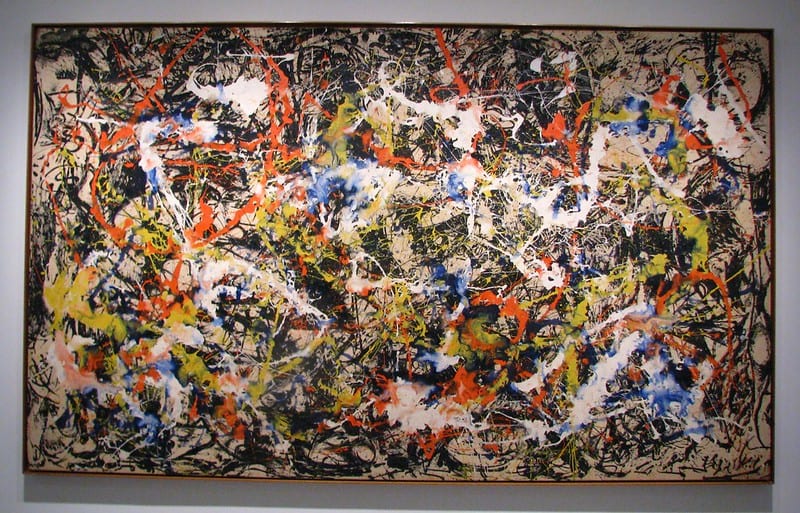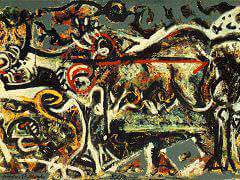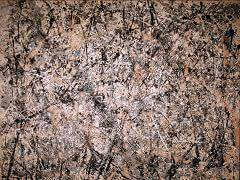Image source – Flickr
Jackson Pollock or Paul Jackson Pollock in full, was a famous American painter, born on January 28, 1912. Credited for being a leading figure of Abstract Expressionism, he was famous for his eccentric nature and signature style of painting. Abstract Expressionism is a modern art moment that involves free-flowing, fluent, and spontaneous gestures. Jackson, a pioneer of abstract art, attracted a wide variety of attention for his unique style. Pouring and splashing liquid paint on a horizontal canvas were important attributes of his painting style. His unconventional style popularly came to be known as ”action painting”, since he painted using spontaneous actions of his entire body. As proclaimed by some of his critics, it was an extreme style of painting that involved random splashing and a radical ”drip” technique.
While some praise his unique style of painting for the spontaneity, subconsciousness, and immediacy, others deem it entirely randomized. Surrounded by controversies for his radical lifestyle and reclusive personality, he was deeply respected by his contemporaries for his dedication towards his work. He had an enormous influence on the modern art moment in the United States. The respect and money his artworks attract indicate the impact he had on the world of art globally. Today his masterpieces fetch millions in auctions. The following list provides a description of some of his most famous masterpieces:
Convergence

Image Source: Flickr
Convergence was created in 1952. It was a time the United States was dealing with a threat of communism and the Cold War. Through Convergence, Pollock dismantled conventions, strongly criticizing societal oppression. The painting is a representation of freedom of speech and expression.
Arguably his most famous work, this masterpiece is a compound of splattered colors and astonishing shapes. The eye-catching patterns are meant to invoke strong emotions in the observer. The brilliant use of confident brush strokes and striking colors combine to form a thought-provoking composition. This enormous 237 cm × 390 cm painting captures your attention immediately.
The popularity of this painting can be assessed by the fact that in 1964 Springbok Editions, a puzzle producing company, launched a Convergence puzzle inspired by Pollock’s painting. The 340-piece puzzle was advertised as the world’s most challenging puzzle. Interestingly, the painting began as a black and white work. Unhappy with the result, Pollock tried to ruin the painting by adding colors. What he managed instead was his greatest masterpiece.
Autumn Rhythm (Number 30)

Image Source: Flickr
Autumn Rhythm is most famous among his drip paintings. Pollock painted this masterpiece in October 1950. By this time, he had already gained popularity as an abstract artist. Pollock produced some of his most notable works in the period between 1947 and 1950. Popularly known as the “drip period,” he discovered a new and unique approach to handling paint.
To create Autumn Rhythm, he applied liquid paint to an unprimed, horizontal canvas laying flat on the ground. The color was dripped and unconventionally dribbled across the canvas. He also poured, splashed, and sprinkled the paint several times during the process. In order to create this lyrical composition with dense and elaborate linear projections, he used trowels, knives – basically anything but traditional artist equipment. He did all this most spontaneously and subconsciously.
To delve into technicality, there is no central point or hierarchy of elements in the painting. Every part of the composition has equal significance, a recurring pattern in several of his works.
The painting is 207 inches (5.26 meters) wide. The size is pretty significant. It meant to encapsulate both- the artist while preparing the piece and the audience while observing it. It almost feels that the artist wanted to store the process of creating the painting within the painting. While the spontaneity of the work needs a special mention, it should not be confused with a lack of control. Pollock himself said that he controlled the flow of paint, so there were no accidents.
Blue Poles (Number 11)
Originally titled as Number 11, the Blue Poles was created in 1952. Giving it just a number instead of a name was another of Pollock’s unconventional gestures, something he did with several of his artworks. It was only in 1954 that the new title (Blue Poles) appeared with the painting at the Sidney Janis Gallery. This ambiguity while naming the painting was supposed to help the observers appreciate the entire piece for what it is, instead of focusing on particular details. The name, as commented by historian Dennis Phillips, forces the observers to look for the poles and miss the rest. He even went on to say that “the name is simply too distracting.”
The painting is a classic piece of abstract expressionism. Acquired by the National Gallery of Australia in 1973, the painting attracted major controversy during the time of its purchase. The deal evoked a great amount of public discourse. The center of this discussion was the cost of the painting. Acquired for a whopping 1.3 million dollars, the price was a record for any contemporary American painting. James Mollison, the director of the National Gallery at the time was not authorized to spend over 1 million dollars for any purchase. The acquisition was approved by Gough Whitlam, the then Prime Minister of Australia.
For the Australian Labor Party, this incident went on to become a much-cited source of Gough Whitlam’s wisdom. It also sparked a global debate on the value of abstract art at the time. Since then, the painting has become a popular exhibit in the gallery. Not only is it valued as a significant work of 1950s abstract expressionism, but it is also marks a special phase in Australian politics. Currently, the painting is evaluated to be anywhere between 20 and 100 million dollars.
Mural

Image Source: Flickr
The Mural is Pollock’s largest painting and holds a significant value in his carrier as an artist. This massive painting, measuring 2.43 by 6.04 meters, marks Pollock’s transition from his earlier works that focused on surrealism to his trademark action painting.
Commissioned by Peggy Guggenheim, this masterpiece was meant for her new townhouse. Once Pollock signed the contract in July 1943, the events that unfolded were fascinating. Initially, Pollock intended to finish the Mural by November for his exhibition. However, as the time approached he did not even touch the canvas. Pollock reported to his friends that he was facing a “block”, killing hours staring at the blank canvas. He became more and more depressed as Guggenheim started pressuring him. Reportedly, he painted it in one burst. As the tale says, Pollock had a frenetic outburst around the New Year of 1944 and completed the painting in almost a day. However, the painting has a date 1943 embarked on it, attracting all sorts of conjectures and commentaries from experts around the world.
As for inspiration, Pollock told a friend of his that he had a vision of a stampede. In this vision, he saw animals charging across the canvas. On a close inspection of the painting, there are suggestions of some figuration in the Mural. Although, not enough for it to be classified as anything else but a fine piece of abstract art.
While painting the Mural, Pollock redefined his limitations and opened doors for a new world of possibilities. Through this masterpiece, he paved the way for an innovative method of painting, combining easel painting with an abstract style. This work possibly led him to venture into his trademark “action painting” technique.
The She-Wolf

Image Source: Wikimedia.org
Painted in 1943, The She-Wolf was inspired by a primeval theme. Pollock, like his contemporaries, explored mythological themes in the early 1940s. This work was produced much before Pollock experimented with his trademark “drip” technique of painting.
The She-Wolf was one of the paintings at Pollock’s first-ever solo exhibition in 1943. The painting was later acquired by MoMA (The Museum of Modern Art), making it the first work by the artist to get featured in a museum collection.
In the painting, the wolf seems to be moving leftwards. Her body, loaded with abstract linear patches and dense projections, reflects a compound composition of unconscious iconography and mythological themes. The primary influence of this work by Pollock seems to be classic surrealism. Prepared before the arrival of his “drip” technique, this piece proves that Pollock’s art was always influenced by an abstract style dominated by free forms.
Lavender Mist, (Number One)

Image Source: Wikimedia.org
Painted in 1950, Lavender Mist is one of Pollock’s earliest experiments with his trademark style of “drip painting”. It was this unique style that won him unprecedented global accolades. Inspired by the marshes and watery light of Accabonac Creek, he painted this astonishing artwork in a customized studio that used to be a barn. Pollock stayed in a small house next to this studio in Long Island from 1945. It was here that he first started practicing the “drip painting” technique. The Lavender Mist is a classic example of his signature style characterized by free-flowing, abstract, and spontaneous contours. Like his other drip paintings, this too focuses on representing the process that went into making it. He signed the painting like a cave painter, using his hand impressions on the upper left corner.
